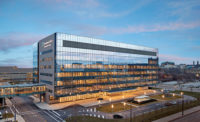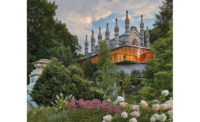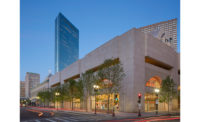For musicians and music lovers worldwide, Tanglewood, in the idyllic Berkshires of Western Massachusetts, is widely considered hallowed ground. Founded in 1937, it hosts one of the globe’s preeminent music festivals and is the summer retreat for the Boston Symphony Orchestra (BSO). The venue has been graced by legendary figures from Leonard Bernstein and Aaron Copland to Bob Dylan and Lady Gaga. But it is equally celebrated for its breathtaking campus, composed of two former estates whose 524 pastoral acres spill out across woodlands and large swaths of manicured lawns, dotted with canopy trees, that open to views of the gently rolling scenery. Tanglewood, says BSO president and CEO Mark Volpe, “is the gestalt of music, nature, and pedagogy.”
While the beautiful pastoral setting has always been the core of the Tanglewood experience, the campus’s built environment is also steeped in history, with Eliel and Eero Saarinen the first architects to have left their mark here. The simple structures scattered across the grounds—like diminutive wood-framed camp-like practice studios or the 5,700-seat fan-shaped Koussevitzky Music Shed (a steel canopy over a dirt floor, inspired by Eliel’s original design)—project a no-nonsense attitude and are open to the outdoors, sending music wafting out, from the trilling of a string quintet to the triumphal swelling of a full BSO rehearsal. New additions to this landscape are not undertaken lightly.
That makes the Linde Center for Music and Learning by Boston’s William Rawn Associates (WRA) especially significant: completed in June, it is Tanglewood’s first major construction in 25 years, since the completion in 1994 of WRA’s burly, top-ranked Seiji Ozawa Hall, with its towering brick facades and barrel-vaulted roof. The Linde treads more softly—a family of three boxy western-red-cedar-clad performance studios with zinc-coated copper standing-seam shed roofs and a low-slung cafeteria, linked by a serpentine covered walkway. Sitting atop a ridge that runs across the campus, the handsome, plainspoken buildings embrace a 100-year-old red oak tree and the vistas beyond.
Sponsored By Tamlyn
The 24,000-square-foot Tanglewood Music Center fellowship program addresses the needs of both the Tanglewood Music Fellowship Program and the just-launched Tanglewood Learning Institute, an initiative offering activities to the public, such as art classes, film screenings, and lectures. Additionally, the Center brings, with its flexible interiors, much-needed new programming space to the campus. The biggest pavilion, the 3,950-square-foot Studio E, with its retractable tiered seating, hosts everything from BSO rehearsals to movies and banquets. And, as the only fully climate-controlled buildings here, the Center can be used off-season.
Rawn’s design sprang from a notion he calls “intensity and informality,” which Tanglewood embodies in its rigorous standards yet casual atmosphere, where barriers between audiences and performers are diminished, and where by day the public uses the grounds as a park. “Tanglewood’s democratic spirit captivated me 30 years ago, as it still does today,” says William Rawn, founding principal, who took lessons learned from his first project here, particularly strategies for connecting the audience to the outdoors with abundant apertures, like Ozawa Hall’s 50-foot-wide barn door. But now, he points out, “it’s doubly important to figure out ways to make Tanglewood more accessible to everyone—make it more than just a conservatory,” because of increasing professional competition.
Though the center was first envisioned as a single building next to Ozawa Hall, the architects broke down the volume so as not to make it imposing. “This was also an opportunity to engage the landscape in different ways,” says WRA design principal Cliff Gayley, “including the spaces between programmatic elements, so you could experience the joy of passing through the landscape as you went room to room.” Working with Reed Hilderbrand landscape architects (which is engaged in an ongoing project to unify and enhance the larger campus), the design team relocated the site up the hill to a former overflow parking lot, because, says Rawn, “We wanted these studios to partake of the lawn as the other buildings do.” Says Reed Hilderbrand principal Adrian Nial, “We moved a lot of earth, but the goal was to make it feel as if it had not been manipulated—that it had always been that way.”
The studios within the complex are trapezoidal, their side walls splaying away from the performing area to push the sound out into the room and allow the abundant use of glass. Acoustics (on which WRA collaborated with Kirkegaard Associates) and a desire for simple forms also drove the team to use shed roofs, which enable the optimal ceiling height, with more compression over the stage area. The volumes are scattered on the site, rather than aligned. “This gives a sense that they aren’t quite perfect,” says Rawn, pointing to other structures here. “The intensity is in their finely tuned acoustics.” While the complex stands out as a more refined version of its predecessors, it complements them in its modesty.
The glazed lower ends of the studios—the larger two of which have fully retractable glass walls—create a dialogue between outside and inside and between the people occupying these spaces and the spontaneous audience that can materialize from passersby. (On hot days, these air conditioned spaces will undoubtedly remain closed, however, challenging the ideal of flooding the campus with sound.) The maple-lined interiors are elegantly spare; the drama comes from the landscape, visible beyond the performance areas. These connections to the larger world will surely energize and inspire musicians and audiences accustomed to more typically cloistered facilities. Outside, the winding walkway links the studios at their front ends, creating a community out of the discrete, intimate spaces. The cafeteria is strictly utilitarian, though its glass front also slides open, expanding the dining area outdoors beneath a broad overhang.
On a recent sweltering afternoon, students conversed on the cafeteria’s terrace, and one young man, lost in the score in front of him, played an invisible string instrument. All the studios were in full swing. People dropped in on a piano master class in Studio E, the moody chords of Chopin filling the space. Beyond the pupil and mentor, the oak leaves wavered in the breeze as curious visitors paused to take in the scene, just as the architects intended, extending Tanglewood’s legacy by engaging with the making of music from yet another vantage point.













Post a comment to this article
Report Abusive Comment